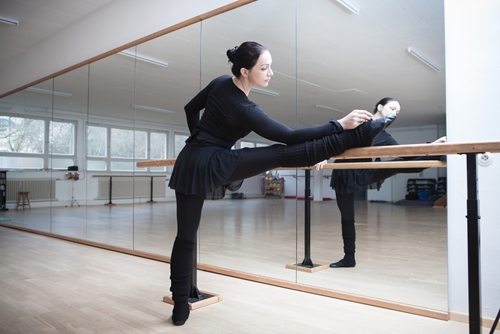When performed correctly, the développé is absolutely mesmerizing – just see how long you watch this gif of Maria Kochetkova. Many dancers, though, struggle with the développé, and instead of being a source of beauty and grace, the move is a source of constant frustration. Every dance teacher has likely heard some of their students complain about their dancer flexibility and the développé.
Kochetkova makes the move look easy, but the développé requires several complex muscle groups to work together in perfect harmony. If just one group is underdeveloped, then the movement is failed from the start. A dancer can be able to do the oversplits with ease but lack the core strength to hold her leg over her head, while a dancer with flexible hips that allow for a wide range of movement can have underdeveloped hamstrings that prevent them from holding her leg in a straight line.
The key to stunning développé extension is thoroughly conditioning all the muscle groups that are involved in the move. Here are four ways that dance teachers can help their students improve their développé extension.
1. Work the Iliopsoas
Everyone’s heard of the hamstrings and hip flexors, but not many people are familiar specifically with the iliopsoas. Which is a real shame, because it’s absolutely vital to sky-high développé.
As Nichelle explained in a very informative article for Dance Advantage, the iliopsoas is the group of muscles that enables the leg to move higher than 90 degrees. For many dancers that are incredibly flexible but unable to lift their legs to their heads, an underdeveloped iliopsoas may be to blame. However, they usually aren’t even aware that this is the problem.
Deb Vogel, a neuromuscular educator, shared several exercises for strengthening the iliopsoas that dance teachers should have their students do.
First, sit up straight on a chair, without your back touching, with both feet on the ground. Keeping your pelvis strong and centered, lift one knee up toward the ceiling, then lower it down so your toes touch the floor. Lift your knee back up, and repeat the movement 20 times for each leg.
Sounds easy, but isolating the iliopsoas like that is a real workout. When your students can do this exercise with ease, have them try this next movement:
Sit in a chair with your back leaning against the back of the chair, and bend one leg at the knee while holding the other leg straight. Keeping the extended leg a little turned out, raise it as high as possible and then lower it back down so it’s even with the other knee. Repeat this movement 20 times, then do it on the other leg.
Vogel advised that dancers follow these exercises, or any other ones that focus on the iliopsoas, with lunge stretches. With these two exercises, it won’t take long to strengthen this important muscle.
2. Strengthen the Core
Dancer flexibility gets much of the attention when it comes to working développés, but core strength is also very vital. A strong core supports all the movements of the développé and ensures that the leg can be held up high while the hips and standing leg are stable. Strong abdominals allow the leg to be held up, but as The Dance Training Project explained, they’re also necessary to keep your spine straight, centered and stable. If you spine is not in a neutral position, then the pelvic alignment will be off, which prevents maximum leg extension.
However, contrary to popular belief, crunches are not the answer for a stronger core, according to The Dance Training Project. Making repetitive concentric contractions – like sit-ups – aren’t effective for building the core strength that dancers need. Instead, dancers should focus on exercises that lengthen the abs and other core muscles – known as eccentric training – so that dancers can achieve a greater range of motion. Planks and abdominal roll-out exercises will provide an eccentric workout, but The Dance Training Project put together a PDF that includes great eccentric core exercises for dancers.
3. Embrace the Floor Barre
Practicing floor barre is also a fantastic way to improve développé extension. Dame Lucette Aldous, a ballerina in the Nureyev rendition of Don Quixote, told Dance Australia how she teaches the Boris Kniaseff method of floor barre to improve her students’ développé.
According to the source, floor barre helps increase overall strength, improve body positioning and posture and even boost circulation, which helps expand range of movement.
“When joints are moving, it sends synovial fluid into the joints – it’s like you’re lubricating those joints,” said Aldous in an interview with Dance Australia.
There are different floor bar techniques for dance teachers to explore. Dance Advantage put together a great guide to the different methods here, including the Boris Kniaseff and Maria Fay techniques.
Editor’s Note: This article has been updated to correct the description of the iliopsoas.



